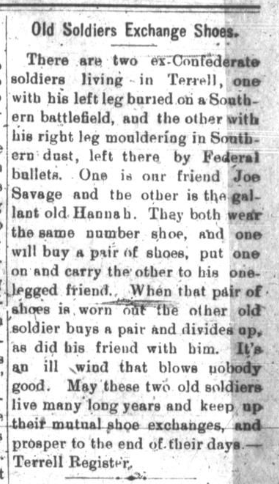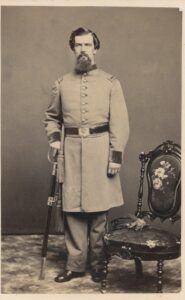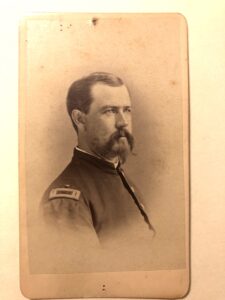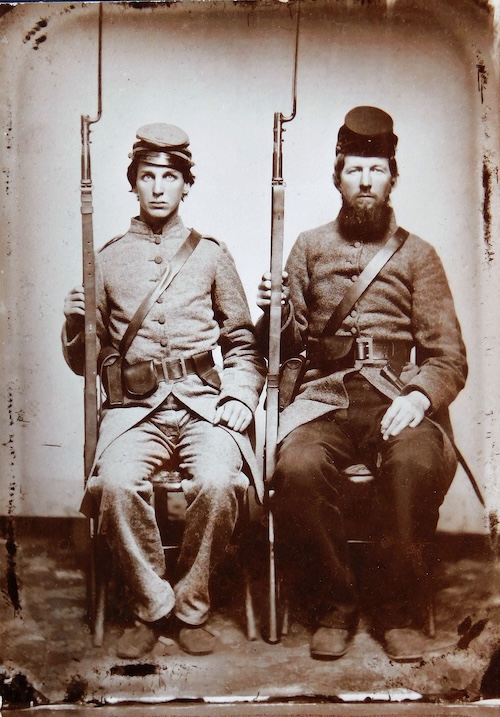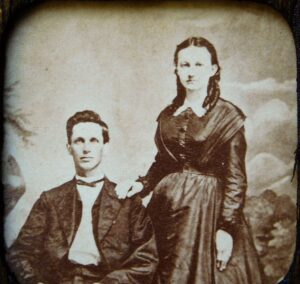Savage shoes
1 July 2025
This from the Terrell, Texas Register by way of the of Fairfield Recorder of 28 August 1896. I’ve not found who “old Hannah” was, but Joe Savage was a Sharpsburg veteran, a Private in the 13th Alabama Infantry. He lost his lower leg and foot to amputation two weeks after he was wounded at Jones’ Farm near Petersburg, VA on 30 September 1864.
Notes
I remember seeing stories like this before – but can’t place them now. Please comment if you know of others. The Fairfield Recorder is online through the Portal to Texas History from the University of North Texas Libraries.
Henry Roger Jones: 4 in uniform
4 June 2025
Here are some excellent photographs of Henry Roger Jones very kindly sent me by his great-great-granddaughter Deborah Burks.
Henry was a 23 year old law student in Illinois in early 1861, but returned to his native state and enrolled as First Sergeant of Company C, 8th Connecticut Infantry in September. Here he is, on the right, in a picture taken with another soldier, not yet identified, about that time:
He was appointed 2nd Lieutenant the next summer and was seriously wounded in combat at Antietam on 17 September 1862 and briefly a prisoner of war there. Disabled for further field service, he was discharged in January 1863 and enrolled in the Veteran Reserve Corps in July 1864. That’s him in VRC uniform in these next two images:
He continued as a First Lieutenant in Regular Army service after the war; with the 43rd US Infantry (VRC) then with the First US Infantry after the two regiments were merged in 1869. Here he is in post-war service:
He retired in 1878 and was promoted to Captain on the retired list in 1904.
Notes
Deborah also transcribed the backs of each of these photographs; from the top down, 1 – 4:.
(1) printed: “Cartes de Visite by Davis, 245 Main Street, Hartford Conn.”
(2) printed: “J. T. Upson, Buffalo, NY”
(3) handwritten: “Henry R. Jones, Adjt, 11th Inv. Corps, Rock Island, Ill. Dec. 26 ’63. [added: Capt 20th VRC];” printed: “G. A. Douglass & Co. (Late Powelson’s) 230 Main Street, Buffalo, N.Y.”
(4) handwritten: “Henry R. Jones, Lieut. USA.;” printed: “R. S. De Lamater, Photographer, No. 258 Main Street, 3 Doors above Post Office [Hartford, CT].”
Rufus King Felder and his cousin Miers Martindale Felder enlisted together in July 1861 near their homes in Washington County, TX, and joined the Dixie Blues, later Company E of the 5th Texas Infantry. They had their photographs taken soon afterward.
Miers was seriously wounded at Manassas, VA on 30 August 1862 and was disabled for further service, but Rufus was with his company through all their battles, including on South Mountain and at Sharpsburg, MD in September 1862, and was surrendered at Appomattox Court House in April 1865.
He returned to Washington County and farmed and raised livestock, amassing a prosperous 800 acre operation by his death at age 82 in 1922.
In 1868 he married preacher’s daughter Margaret Eliza Matthews (1847-1884) and she bore him eight children. I believe these are the newlyweds:
Margaret died in 1884 birthing their last child, daughter Margaret Eliza (1884-1978), and Rufus re-married the following year, 20 year old Mary Loula Virginia Nelson (1865-1942), daughter of a local physician. Rufus was then 45. They had 4 more children by the turn of the century.
Notes
The photographs above were shared to Rufus’ memorial by Karen Webster in 2018; the picture of Rufus and Miers is in the Texas Heritage Museum at Hill College, Hillsboro, TX.
